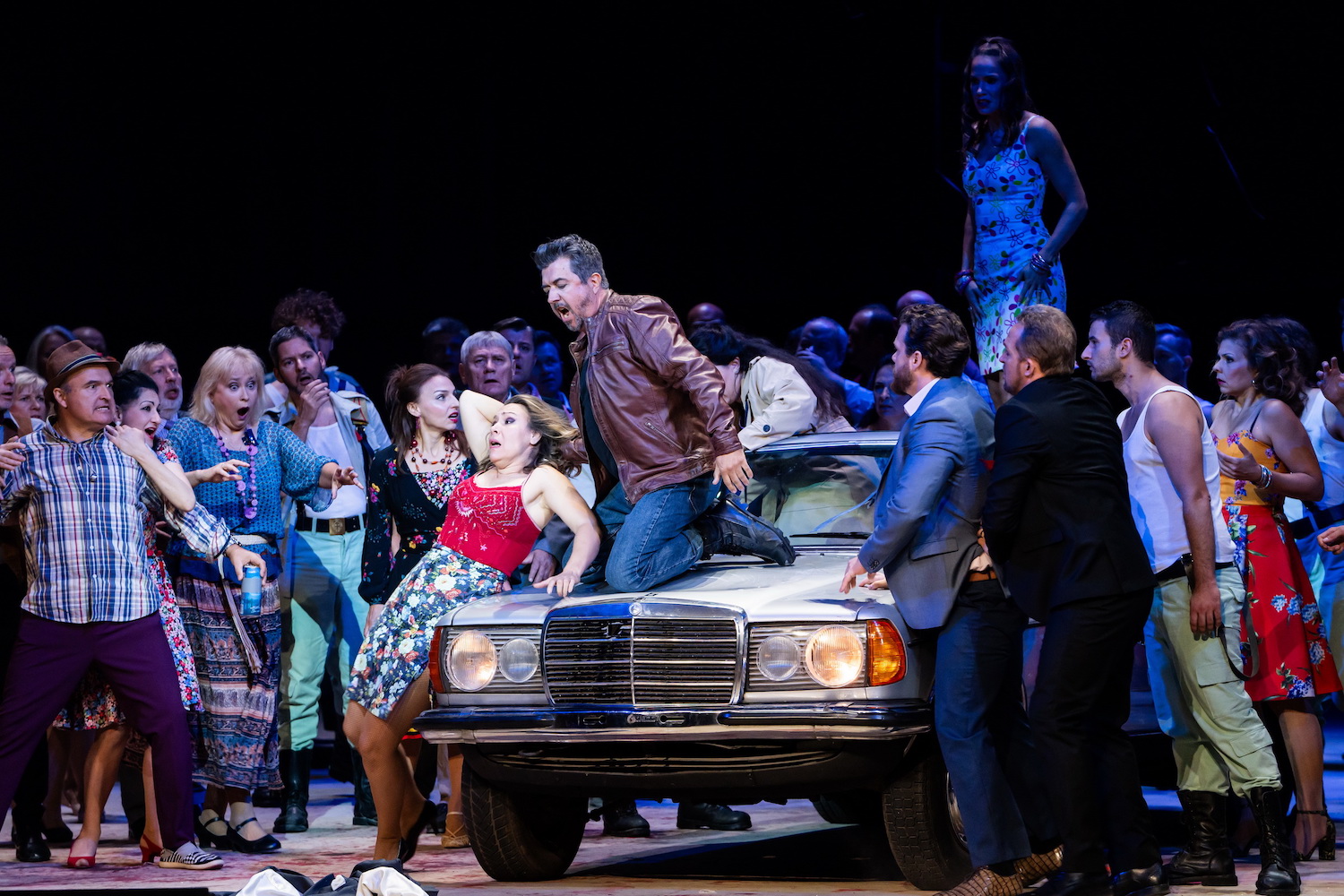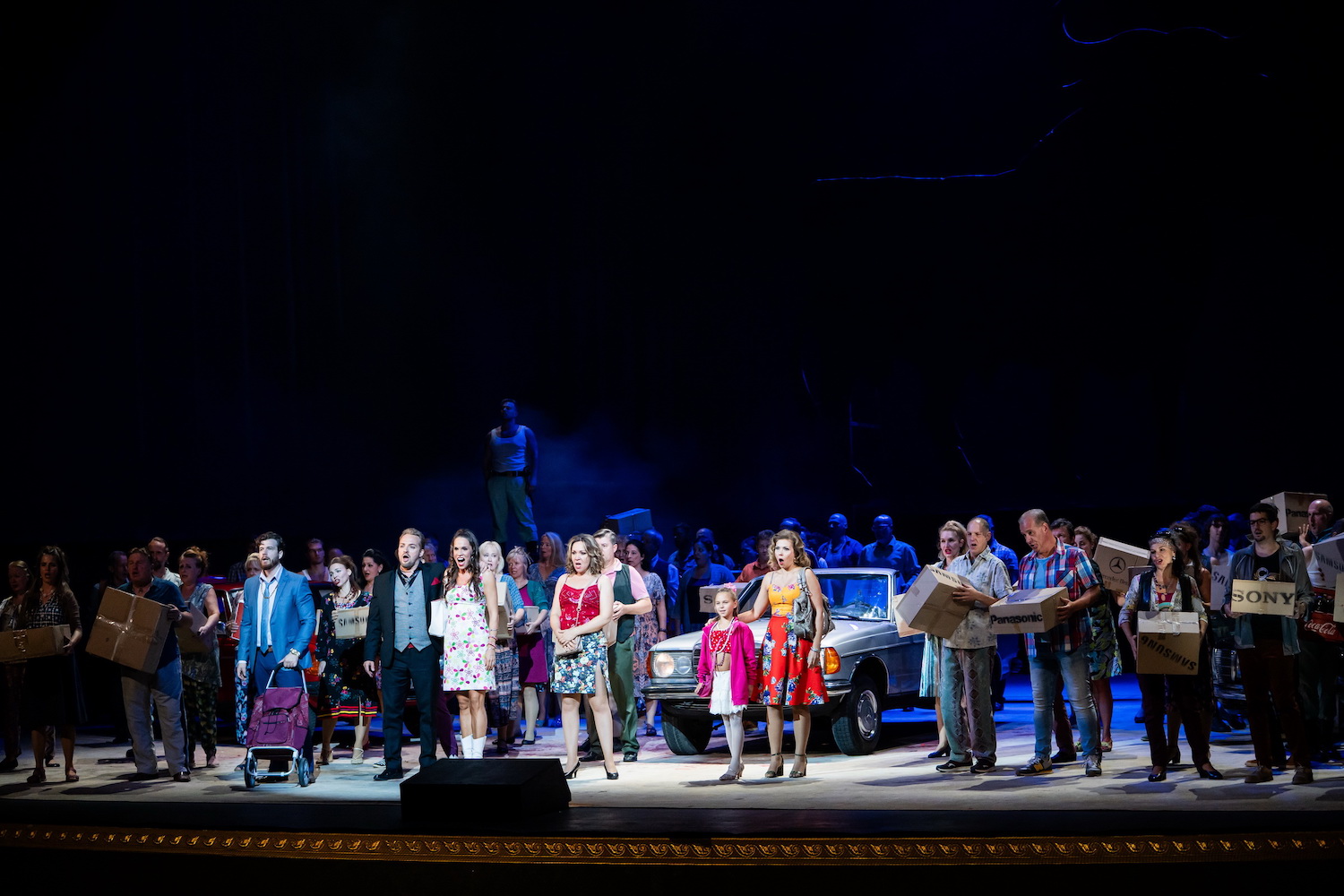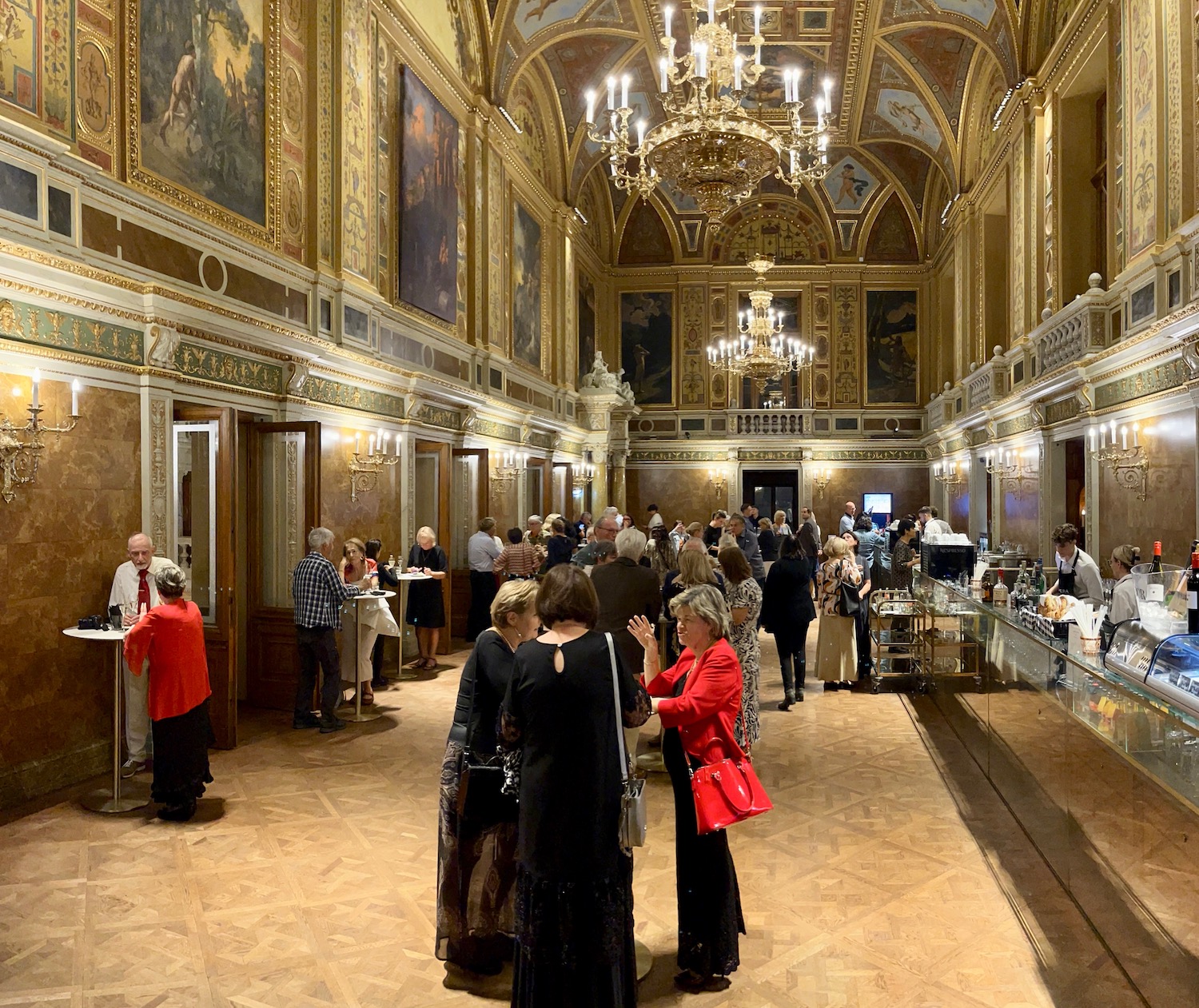An intoxicated man dressed in a white suit, wearing a panama hat enters during the ouverture. He announces that ‘Love is like Death’. I’m not sure who he is quoting, but it’s not Nietzsche, who apparently saw the opera at least 20 times between 1881-1888.
A chorus consisting of more than 40 soldiers marches in and takes up the whole wide stage. While they sing, a single soldier, naked but for his underpants and holding an AK-47 rifle, runs circles around the men lined up. His punishment served, he collapses after some 20 laps. A group of street urchins, young girls, beg for food from the military cook while singing that they make a valuable contribution to the country: Les épaules en arriere, et la poitrine en dehors….etc.. Its immediately clear that the action takes place in a poor neighbourhood. The soldiers are waiting for Carmencita and all the other saucy women from the tobacco factory that are about to have their lunch break. A woman with long jet black hair and a good pair of legs emerges out of the dark, unfazed by the men eyeing her up. She sits down on the floor, centre stage, and lights a cigarette. This cool lady entrance is a clever red herring planted by director Calixto Bieito, because the real Carmen (Viktória Mester) turns out to have a fiery row over the phone in a booth stage right. She has curly shoulder-length brown hair and wears a black negligé under her front buttoned work dress. The soldiers surround, touch, grope and challenge her. But she’s not a bit intimidated, she can handle this lecherous lot. This bird’s not easily caught, she sings in the Habanera (L’amour est un oiseau rebelle, Que nul ne peut apprivoiser). It’s only when she falls in love that she’s no longer fully in charge. Unfortunately for her, she falls in love too easily and never stays with a man for more than six months. When the rather serious corporal Don José (László Boldizsár) doesn’t react to her flirtation, she feels challenged and throws him a flower. Don José has a fiancée, the country girl Micaëla (Andrea Brassói-Jőrös) who has come to deliver some money and a message from his mother. She craves affection, they take selfies, as modern lovers do, but Carmen has already cast a spell over Don José and he ends up breaking the cameras. He’s distracted, sings about his mother, rather than Micaëla. Boldizsár is a convincing Don José, has the lyrical capabilities required for this Act and doesn’t linger on high notes. Don José is ordered by the officer in charge to go and get Carmen, who has injured a girl during a fight in the factory. Tied to a post and left alone with Don José Carmen starts to employ her feminine wiles upon him and he can no longer resist. Viktória Mester’s voice may not always have the fire and sparkle, her timbre is that of an alto, but her interpretation of the seguidilla ‘Pres des ramparts de Seville..’ can make most men go weak at the knees. She is a self-assured Carmen, acts the part very well, and no man is going to box her in. Don José decides to assist her escape, which lands him in prison.
In Act I Calixto Bieito leaves the stage more or less bare, filling it with chorus and crowd scenes when needed. After the interval things change. Toreador Escamillo (Csaba Sándor) appears dressed in an ordinary suit. He locks eyes with Carmen and the attraction is mutual. Sándor is a competent tenor, but the character could be painted with a broader brush. He doesn’t quite project the bravado, nor does he ooze the confidence that we expect from the character. This is also where the opera turns and becomes a drama. Don José is released from prison and now admits that he has fallen passionately for Carmen. She dances and sings for him , but when he hears the bugle call Don José wants to return to the barracks, back to his normal life. Carmen reacts with indignation and outrage. Cue Don José’s Flower Song and Boldizsár manages to break a quite a few of the audience members’ hearts. Mind you, he still feels obliged to return to the army. But when Don José’s commanding officer Zuniga turns up jealousy, for the first but not the last time, becomes a factor. Zuniga has his sights set on Carmen and the rivalry between the two soldiers ends in a fight. The officer is disarmed by Carmen’s smuggler friends and dragged off. Don José has no choice but to join Carmen’s gypsy smuggler gang that are planning a big operation.

In the Third Act the silhouette of the iconic and massive black Osborne bull emerges out of the mist. In the dark a naked dancer rehearses a toreador routine. It’s quite an impressive sight when the smugglers start wheeling in five (90s vintage) Mercedes. Don José has joined the troupe, but he’s is clearly unhappy in this mountain hideout, not helped by Carmen stoking her lover’s gloomy demeanor and threatening to send him home. Yes, we all know that gypsies can predict the future by reading playing cards and Carmen is no exception. It turns out her and Don José’s destiny is death. By the time Micaëla enters to tell Don José his mother is dying, everyone is gone. Left alone Andrea Brassói-Jőrös performs her sad and desperate aria, Je dis que rien ne m’épouvante, with poise and some stoicism. Escamillo has also made his way to the smugglers’ camp, but he is looking for Carmen. Instead he finds Don José, but this toreador is not interested in a scrap and runs away from a duel, over the roofs of the Mercs.
ACT IV’s opening chorus is one of the highlights of this brilliant staging. A crowd of close to a hundred singers fill the whole width of the stage, welcoming the cuadrillas and toreadors. The crowd moves up to the front of the stage, dancing and jumping up and down to catchy tune of the bull fighters’ theme. This colourful scene injects a fantastic amount of energy into the last act. Carmen has a brief moment to declare her love to Escamillo, but then, while the cheering and singing of the bullfight spectators can be heard in the background, she meets Don José alone outside the arena. He implores Carmen to come away with him and Boldizsár’s (Don José) plea has a threatening undertone (or is it just his dark looks?). But Viktória Mester’s Carmen knows her fate is sealed. She knows there can only be one outcome; just like the fate of the bull in the bullring is certain, so is her final destiny . Defiantly Carmen sings ¨Libre eller est née et libre elle mourra¨ Death is a kind of liberation and Carmen knows her time has come.
This is a great production with some solid singing and in general excellent acting. The State Opera orchestra is probably one of the most hard working opera ensembles in Europe, with an extremely busy calendar. The House has had a ropey reputation, damaged by Orban influenced politics, but this production deserves to be reckoned with.
The State Opera’s Principal guest conductor Péter Halász made sure that the orchestra was alert and never overwhelmed the singers. More importantly the tempo never slackened.
Calixto Bieito’s contemporary interpretation of Carmen was premiered 25 years ago and it has been staged in more than 20 countries. Yes, you can find Teatro La Fenice’s production on YouTube, but nothing on screen comes near the energy you feel in a live performance. It will make your post-theatre dinner in Budapest’s Lipotvaros district all the more tasty.
https://www.opera.hu/en/programme/2024-2025/carmen-2024/

THE BUILDING
The Hungarian State Opera’s exterior and spectacular neo-renaissance interior are so picturesque that on social media platforms the building appears to be more popular than the company’s actual productions. You can do a 45-minute tour of the house, which includes a 10-minute mini-performance, but the guided tour is apparently so popular that you need to book it well in advance. On the other hand, tickets to the full-length opera performances seem to be readily available. For the price of the ticket you get plenty of time to study the frescos, the vaulted ceilings, the marble columns, the grand staircase and you get a chance to have a relaxed drink in the over-the-top, Gilded Age foyer. Not to forget, you get to see a grand opera as well!


